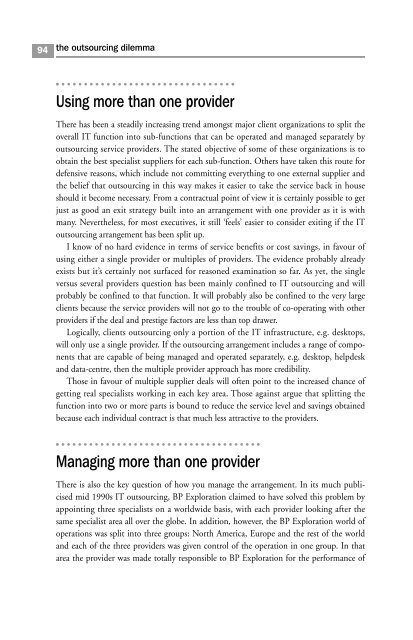The Outsourcing Dilemma - The Search for Competitiveness.pdf
The Outsourcing Dilemma - The Search for Competitiveness.pdf
The Outsourcing Dilemma - The Search for Competitiveness.pdf
You also want an ePaper? Increase the reach of your titles
YUMPU automatically turns print PDFs into web optimized ePapers that Google loves.
94<br />
the outsourcing dilemma<br />
Using more than one provider<br />
<strong>The</strong>re has been a steadily increasing trend amongst major client organizations to split the<br />
overall IT function into sub-functions that can be operated and managed separately by<br />
outsourcing service providers. <strong>The</strong> stated objective of some of these organizations is to<br />
obtain the best specialist suppliers <strong>for</strong> each sub-function. Others have taken this route <strong>for</strong><br />
defensive reasons, which include not committing everything to one external supplier and<br />
the belief that outsourcing in this way makes it easier to take the service back in house<br />
should it become necessary. From a contractual point of view it is certainly possible to get<br />
just as good an exit strategy built into an arrangement with one provider as it is with<br />
many. Nevertheless, <strong>for</strong> most executives, it still ‘feels’ easier to consider exiting if the IT<br />
outsourcing arrangement has been split up.<br />
I know of no hard evidence in terms of service benefits or cost savings, in favour of<br />
using either a single provider or multiples of providers. <strong>The</strong> evidence probably already<br />
exists but it’s certainly not surfaced <strong>for</strong> reasoned examination so far. As yet, the single<br />
versus several providers question has been mainly confined to IT outsourcing and will<br />
probably be confined to that function. It will probably also be confined to the very large<br />
clients because the service providers will not go to the trouble of co-operating with other<br />
providers if the deal and prestige factors are less than top drawer.<br />
Logically, clients outsourcing only a portion of the IT infrastructure, e.g. desktops,<br />
will only use a single provider. If the outsourcing arrangement includes a range of components<br />
that are capable of being managed and operated separately, e.g. desktop, helpdesk<br />
and data-centre, then the multiple provider approach has more credibility.<br />
Those in favour of multiple supplier deals will often point to the increased chance of<br />
getting real specialists working in each key area. Those against argue that splitting the<br />
function into two or more parts is bound to reduce the service level and savings obtained<br />
because each individual contract is that much less attractive to the providers.<br />
Managing more than one provider<br />
<strong>The</strong>re is also the key question of how you manage the arrangement. In its much publicised<br />
mid 1990s IT outsourcing, BP Exploration claimed to have solved this problem by<br />
appointing three specialists on a worldwide basis, with each provider looking after the<br />
same specialist area all over the globe. In addition, however, the BP Exploration world of<br />
operations was split into three groups: North America, Europe and the rest of the world<br />
and each of the three providers was given control of the operation in one group. In that<br />
area the provider was made totally responsible to BP Exploration <strong>for</strong> the per<strong>for</strong>mance of















